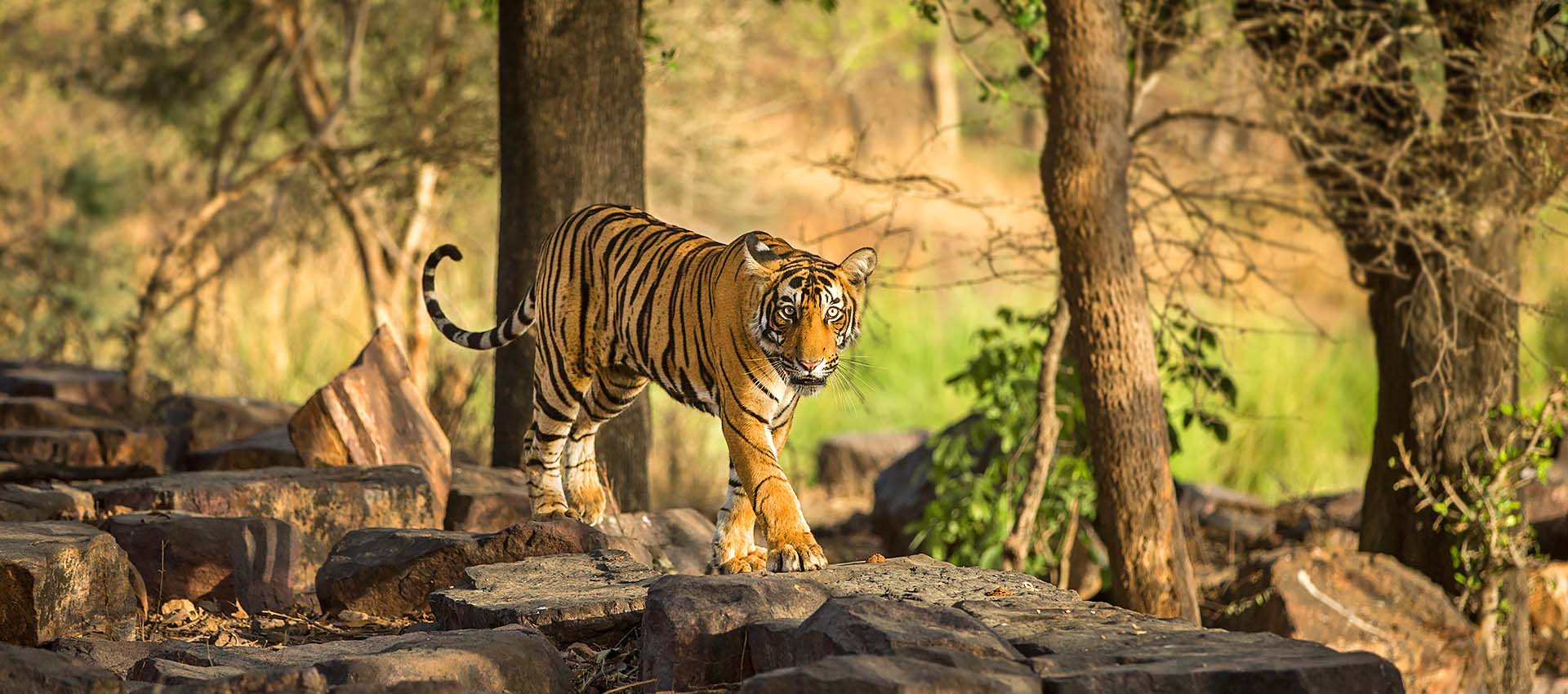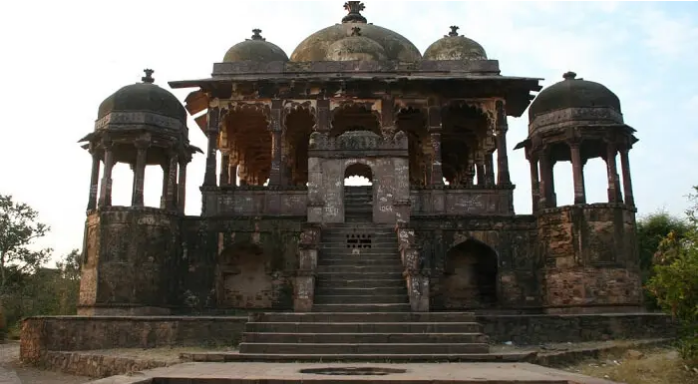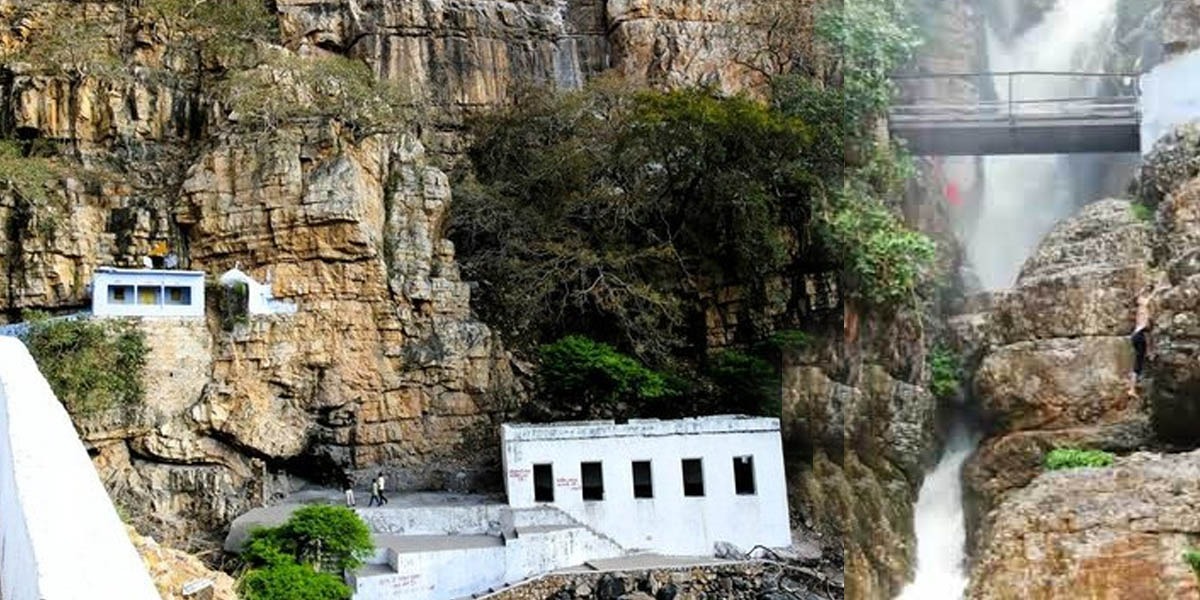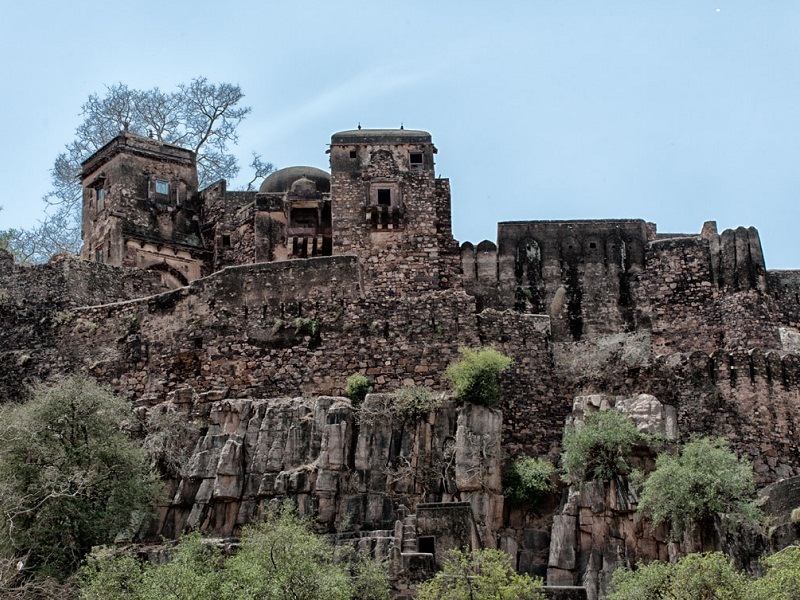

Embark on an enthralling exploration of Ranthambore National Park, a wildlife sanctuary in the heart of Rajasthan, India. Known for its rich biodiversity and, of course, the majestic Royal Bengal Tigers, Ranthambore offers an experience that lingers in the memory forever.
Tiger Sighting and Safari Experience: The highlight of Ranthambore is undoubtedly the chance to spot the elusive Royal Bengal Tigers. With activities like jeep safari and canter safari, the park promises an unparalleled wildlife sighting experience. Choose between a 6-seater gypsy or a 20-seater canter, both open from all sides, for morning and evening safaris.
Wildlife Photography Paradise: Ranthambore's diverse landscape, coupled with relatively easy tiger sightings and excellent lighting conditions, makes it a haven for wildlife photographers. Capture shots of various animals and birds against the stunning backdrop of forts, palaces, and ruins scattered throughout the park.
Flora and Fauna: The terrain alternates between dry deciduous forests and open grassy meadows, boasting about 539 species of flowering plants. The Dhok tree dominates, complemented by mango, tamarind, and banyan trees. Home to a diverse array of mammals, reptiles, and birds, Ranthambore boasts a thriving ecosystem. From Royal Bengal Tigers to leopards, sloth bears, and various deer species, the park is a treasure trove for wildlife enthusiasts. Marsh crocodiles, reptiles, and a plethora of bird species add to the vibrant tapestry of Ranthambore's biodiversity.
Safari Zones: Explore the park's ten safari zones, each offering a unique landscape and wildlife experience. From the buffer zones (1-5) to the newer zones (6-10),
witness the magic of Ranthambore through varied terrains, water holes, and diverse flora.
Zone 1
: Home to T-39 and T-57, offering numerous sightings, especially around Tuti
ka Nalla and Amreshwar Dang.
Zone 2: Important for water holes, sightings of T-19, T-22, T-72, and more. Jogi Mahal, Phuta Kot, and Nal Ghati are key points.
Zone 3: Features Padam Talab, a vantage point for T-19 and T-28 sightings. Other highlights include Jogi Mahal and High Point.
Zone 4:Known for shy cat sightings and once the home of the famous Machli. T-28, T-64, T-19, and others can be spotted at Singh Dwar, Malik Talab, and Lakkad Da.
Zone 5: Similar to Zone 4, with common spots for sightings. Singhdwar, Anatpur, and Jokha are key points. T-25, T-28, T-17, and more can be observed.
Zone 6 (Kundal): Offers different landscapes with open grasslands and mountains. Features sightings of T-34, T-39, T-57, and T-8.
Zone 7 (Chidikho): Fewer points but sightings of T-8 and T-34 have been reported at Chidikho, Jamoda, and Rajbagh Naka.
Zone 8 (Balas): T-8 and T-34 sightings, including Balas, Kherai, and Mahakho.
Zone 9 (Kuwal ji): Located at the banks of the Chakal river, home to T-42 (Fateh) and T-59. Also houses Caracals, Sloth bears, and aquatic birds.
Zone 10 (Aantri): Ideal for birding and sightings of T-13, T-42, and T-43 at Aantri, Kushalipura, and Halonda.
As you venture into the heart of Ranthambore National Park, you'll be greeted by a spectacle of nature's wonders, promising an experience that transcends the ordinary. From the mesmerizing landscapes to the thriving wildlife, Ranthambore is a symphony of sights and sounds waiting to be explored. To reserve your journey, reach out to our front desk team via intercom at extension 9 or contact our reservations team directly at +91-9116169001.

Situated in Sawai Madhopur, the National Chambal Gharial Sanctuary emerges as a captivating jewel within the realm of Ranthambore's tourist attractions. Offering a unique rendezvous with nature, the Chambal River Safari at this sanctuary stands out as a splendid alternative to the traditional Jungle Safari.
Historical Context and Location: Located in Palighat Village, Sawai Madhopur, adjacent to the serene banks of the Chambal River, this sanctuary holds historical significance. The Chambal River, approximately 45 kilometers from Ranthambore,was once infamous for dacoits in the 1970s. To safeguard the rare crocodile species inhabiting the river, the government declared the area a wildlife sanctuary on December 7, 1979, known as the National Chambal Gharial Wildlife Sanctuary.
Geographical Overview: Stretching over 425 km, the sanctuary boasts a width of 2-6 km on both sides of the Chambal River. Spanning across three states – Madhya Pradesh, Rajasthan, and Uttar Pradesh – the sanctuary forms a natural border between these regions. Starting from Kota Barrage in Rajasthan, the sanctuary follows the course of the Chambal River through Sawai Madhopur, Morena in Madhya Pradesh,
and Dholpur in Rajasthan.
Biodiversity and Attractions: The sanctuary's main attractions include the Gharial, thriving in their natural habitat. For wildlife enthusiasts on a Ranthambore tour, the Chambal River is a haven for exploring rare crocodile species, such as the Gharial, and the National Aquatic Animal, Gangetic Dolphin.
For bird lovers, Pali Ghat Chambal River is a paradise, boasting over 316 species of migrant and resident birds. From Indian Skimmers, Ruddy Shelducks, to the majestic
Indian Courser, the sanctuary is a vibrant canvas of avian diversity. Indian Skimmers, Great Stone-Curlew, and Lapwing form large nested colonies, enhancing the avian
spectacle.
River Safari Experience: During the Chambal Safari, visitors encounter a fascinating array of amphibians and aquatic animals, including Marsh Crocodiles, Gharial, various turtle species, Smooth-coated Otter, and Gangetic Dolphins. Terrestrial mammals, such as Wild Boar, Blue Bull, Jungle Cat, and Indian Fox, add to the sanctuary's rich biodiversity.
Flora and Sunset Experience: The flora surrounding the Chambal River includes Palash, Khair, Ber, Churel, and Babul, creating a picturesque landscape. The best time to embark on a Chambal River Safari is from November to March, offering favorable weather conditions.
For an unforgettable experience, explore the Pilighat during Chambal River Safari, armed with binoculars and cameras to unravel the mysteries of Pali Ghat.
To reserve your journey, reach out to our front desk team via intercom at extension 9 or contact our reservations team directly at +91-9116169001.

Nestled within the historic walls of the Ranthambore Fort, the Trinetra Ganesh Temple stands as a timeless testament to devotion and divine intervention. This sacred sanctuary, renowned as one of the oldest temples in Rajasthan, unfolds a captivating narrative that transcends centuries.
History of Trinetra Ganesh Temple: The roots of this revered temple delve deep into the annals of 1299, a tumultuous period marked by the intense battle between King Hameer and Ala-ud-din Khilji within the confines of Ranthambore Fort. King Hameer, a steadfast devotee of Lord Ganesha, found solace in seeking the blessings of the elephant-headed deity even amidst the chaos of war. In a divine revelation, Lord Ganesha appeared in King Hameer's dreams, assuring him of liberation from the adversities that besieged him. The following morning bore witness to a miraculous symbol of Lord Ganesh manifesting on one of the fort's walls. Astonishingly, the war, which had raged on relentlessly, came to an abrupt and unexplained halt.
Aarti Timings: Experience the divine rhythm of daily rituals at Trinetra Ganesh Temple, where the soul-stirring Aartis become a channel for spiritual connection.
Prabhat Aarti (Early Morning Aarti): Witness the sunrise unveiling the divine with the Prabhat Aarti.
Sringar Aarti (Morning Aarti): At 9 AM, immerse yourself in the devotion of the Sringar Aarti, a mid-morning ode to Lord Ganesha.
Bhog (Midday Offering): Noon brings the Bhog ceremony, a sacred offering to the deity.
Sandhya Aarti (Evening Aarti): As the sun sets, partake in the Sandhya Aarti, resonating with the divine energy. (6:30 PM in Summer, 5:45 PM in Winter)
Shayan Aarti (Night Aarti): Shayan Aarti at 8 PM, a serene closure to the temple's daily rituals.
The Trinetra Ganesh Temple isn't just a place of worship; it's a living chronicle, a sanctuary where history, faith, and divine grace converge. As you step into its sacred precincts, be prepared to embark on a spiritual journey that transcends time and connects you to the celestial realms. To reserve your journey, reach out to our front desk team via intercom at extension 9 or contact our reservations team directly at +91-9116169001.

Situated approximately 7 km from the Railway station on the route to Ranthambore National Park, the Amareshwar Mahadeo Temple stands as an ancient haven of spirituality. This oldest Shiva temple, also known as Amareshwar Mahadeo, is nestled amidst towering hills, exuding an aura of sacredness.
Dating back around 1200 years, Amareshwar Mahadeo Temple shares its antiquity with the historic Ranthambhore Fort, discovered over 300-400 years ago. Initially
concealed by dense forests, reaching the temple in earlier times posed a formidable challenge. Today, a one-kilometer journey through the forest area along the
Ranthambhore road, either by foot or vehicle, unveils this timeless sanctuary.
Religious and Historical Significance: Amareshwar Mahadeo Temple has evolved into one of the prominent religious attractions near Sawai Madhopur, surrounded by lush green hills. On the auspicious day of Shivaratri, the temple transforms into a vibrant fair (Mela) during daylight hours, followed by a night-long Jagaran. Devotees flock to the temple to offer their reverence to the deity, creating an atmosphere steeped in spirituality.
Natural Beauty and Picnic Spot: Beyond its religious and historical eminence, the temple has become a favored picnic spot for the locals, especially during the rainy season. The enchanting waterfall, meandering nullah, and picturesque groves add to the allure of the surroundings. Men and women have separate bathing areas, enhancing the temple's accessibility and appeal.
Tourist Attraction: Amareshwar Mahadeo Temple attracts tourists not only for its religious significance but also for the captivating natural beauty that envelopes it. The fusion of spirituality and scenic charm creates an inviting ambiance, making it a must-visit destination for those seeking a tranquil retreat.
Embark on a journey to Amareshwar Mahadeo Temple, where history, spirituality, and nature converge, offering an experience that transcends time. To reserve your journey, reach out to our front desk team via intercom at extension 9 or contact our reservations team directly at +91-9116169001.

Nestled within the heart of Ranthambore National Park, the imposing Ranthambore Fort bears witness to centuries of history, standing as a sentinel on a majestic hill soaring 700 feet above. Recognized as a UNESCO World Heritage Site under the distinguished "Hill Forts of Rajasthan," this fort is an integral part of the region's rich heritage.
Originally erected in the 10th century by the Chauhan dynasty as a fortress for security, the fort later fell under the dominion of the Delhi Sultanate in the 13th century. Steeped in Rajasthani architecture, the fort boasts towering gates, majestic domes, well-paved stone pathways, formidable walls, ancient water tanks, and ornate temples that echo the grandeur of the bygone era.
As visitors traverse through one of the seven gates – Ganesh Pol, Andheri Pol, Navlakha Pol, Hathi Pol, Satpol, Suraj Pol, and Delhi Pol – they embark on a journey through time. The Mahadeo Chhatri, Toran Dwar, and Sametonki Haveli stand as testaments to the fort's architectural brilliance, beckoning exploration.
A visit to the Ganesha Temple within the fort is a spiritual experience, attracting devotees in abundance. The temple, steeped in reverence, adds a divine touch to the fort's historical grandeur.
Beyond the historical allure, the fort offers breathtaking panoramic views of Ranthambore National Park, making every visit a visual feast. Open to all from 6:00 AM to 6:00 PM, the fort invites guests to witness the enchanting sunset, a spectacle that adds a touch of magic to the ancient stones.
Entrance to the Ranthambore Fort is free, welcoming all who seek to immerse themselves in its historical embrace. For an optimal experience, plan your visit between April and October, when the weather is most inviting, and the fort reveals its secrets against the backdrop of nature's splendor.
To reserve your journey, reach out to our front desk team via intercom at extension 9 or contact our reservations team directly at +91-9116169001.